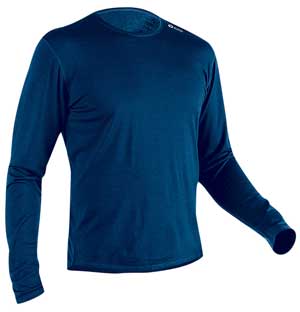While it’s entirely possible (and indeed commonplace) to ride bikes in a simple cotton t-shirt, it’s not such a great idea. Under certain circumstances (gently trundling to the pub on a warm day) tees are fine, but as soon as you start to exert yourself, their limitations rapidly become apparent.
The thing is, unless you’re a cyborg or something when you put in a reasonable degree of physical effort you’ll start to sweat. This is a good thing – it’s how the body cools itself down. Without sweating, you wouldn’t be able to ride hard for very long. But the sweating mechanism doesn’t take account of clothes.
A conventional t-shirt will quite happily soak up substantial quantities of perspiration. The problem is that by soaking it up it holds onto it. And pretty quickly you’re riding around in a sopping wet garment that’s chafing all over the place. Worse, stop riding and you’ll get cold very quickly. Which is where base layers come in…
Fabric
For any sort of serious riding, you need a more capable fabric. Base layers are thin garments designed to be worn next to the skin with other stuff on top. What’s so clever about them? They’re usually made of magical fabrics that “wick” moisture. Which means that instead of holding on to it like the t-shirt, they transport it from your skin to the outside world where it evaporates, just as it would were you not wearing a shirt at all but with added insulation.
There are a few ways to achieve this remarkable result. It can be done mechanically (the way in which the material is woven allows it to wick) or chemically, with some sort of treatment to the fabric. Clearly if it’s an attribute of the weave the wicking ability won’t wash out, although treated fabrics are generally pretty durable as long as you don’t go mad and boil them or something. Base layer fabrics are generally synthetics, although Merino wool achieves the same result naturally. It needs careful washing, though.
The most recent innovation in base layer fabrics, and something to look out for, is anti-pongness. Old-style polypropylene base layers were notorious for quickly taking on a pungent and permanent pong, but several fabrics now have anti-bacterial treatments to ward off the niff, and the lighter, open-weave garments don’t suffer too badly anyway.
Fit
Base layer fit depends a bit on application. To wick effectively they really need to be in contact with your skin, so a closer fit is best. A slightly looser fit adds to versatility, though – quite a few base layers are quite at home worn on their own, and a number of manufacturers make t-shirts out of their magic fabrics too. Generally we tend to wear a bike jersey if we’re only wearing one garment (we like pockets) – if your base layer is only going to get used underneath other stuff as part of a layering system then go for a closer fit.
Feel, finish and features
The feel of the various fabrics differs quite a lot. Some are soft, some shiny, some thin, some quite thick. We prefer the soft, thin ones but really it’s personal preference. You’ll probably end up with a small selection, with thicker ones for midwinter. Zips are a common but not universal base layer feature. Again, this is your choice. A zip-fronted garment gives a bit of scope for ventilation if you get too warm but adds weight and cost.
Looking for a new base layer? It’s worth checking the member reviews for what other readers think of base layers they’ve bought.


